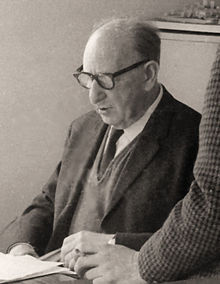Arthur Korn (architect)
| Arthur Korn | |
|---|---|

Arthur Korn at the Hammersmith College of Art and Building in London
|
|
| Born | 4 June 1891 Breslau, Germany |
| Died | 14 November 1978 Klosterneuberg, Austria |
| Nationality | German |
| Occupation | Architect |
Arthur Korn (4 June 1891 – 14 November 1978) was a German Jewish architect and urban planner who was a proponent of modernism in Germany and the UK.
Born in Breslau (now Wroclaw) in Silesia in 1891. Between 1909 and 1911 he studied at the Königliche Kunst- und Kunstgewerbeschule (Royal Art and Trade School) in Berlin. After World War I he worked briefly at the office of expressionist architect Erich Mendelsohn. In the 1920s he was active in the modernist architectural movement in Berlin, and associated with Bauhaus architects such as Walter Gropius and Ernst May. He was a member of Der Ring Berlin architectural collective. He published his influential work Glas. Im Bau und als Gebrauchsgegenstand (published in English as Glass in Modern Architecture) in 1929. After the Nazi rise to power he was forbidden to practice as an architect in Germany on account of being Jewish. He moved first to Yugoslavia, then, in 1938, to London. There he joined the Modern Architectural Research (MARS) Group where, as chair of the town planning subcommittee, he was involved in drawing up the modernist MARS plan for post war London published in 1942. Between 1941 and 1945 he taught architecture and planning at the Oxford School of Architecture, then in London from 1945, not only at the Architectural Association, where his teaching contribution became widely known, but also at the Hammersmith College of Art and Building, for whose School of Architecture he is credited as being one of the major influences in its re-emergence after the Second World War. He was for many years a resident in the Isokon flats in Lawn Road, London, and retired in 1965 before moving to Austria in 1969.
...
Wikipedia
